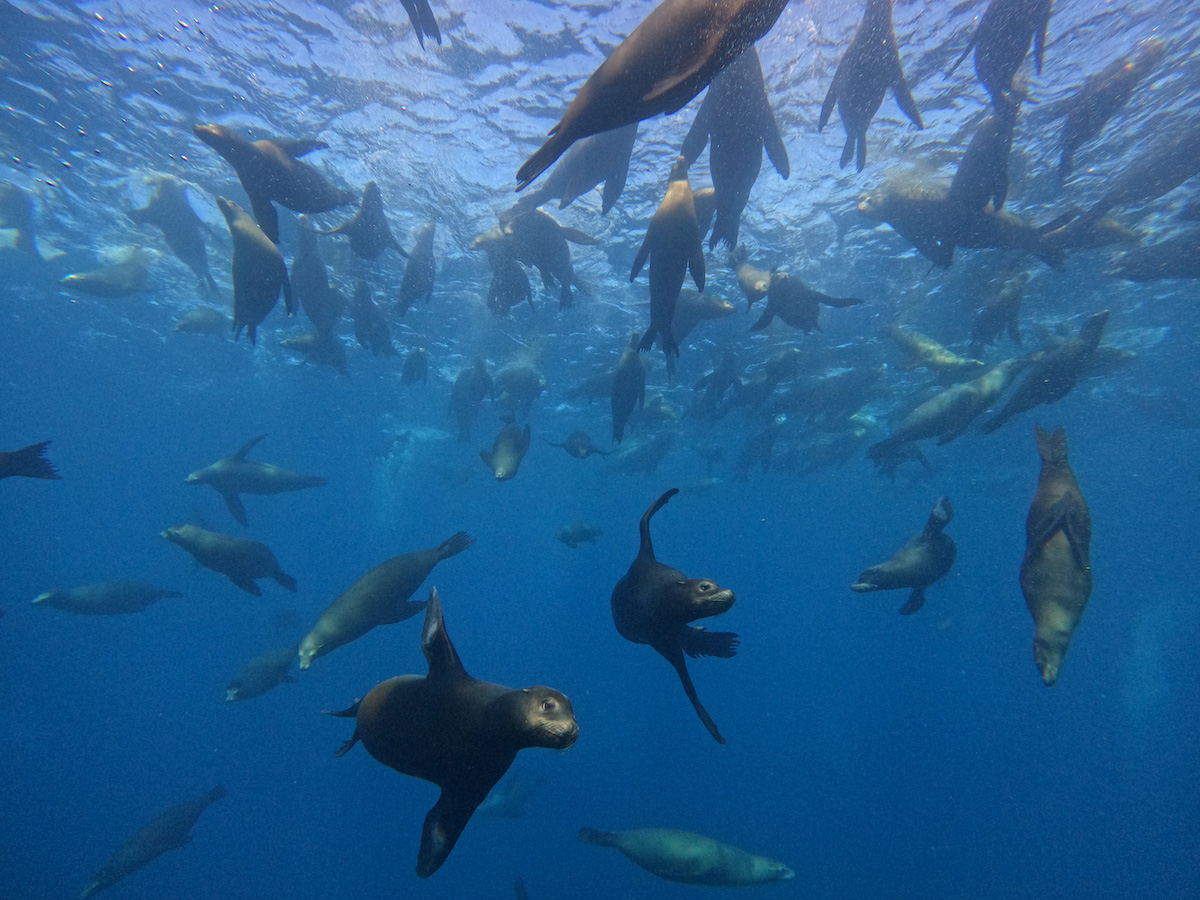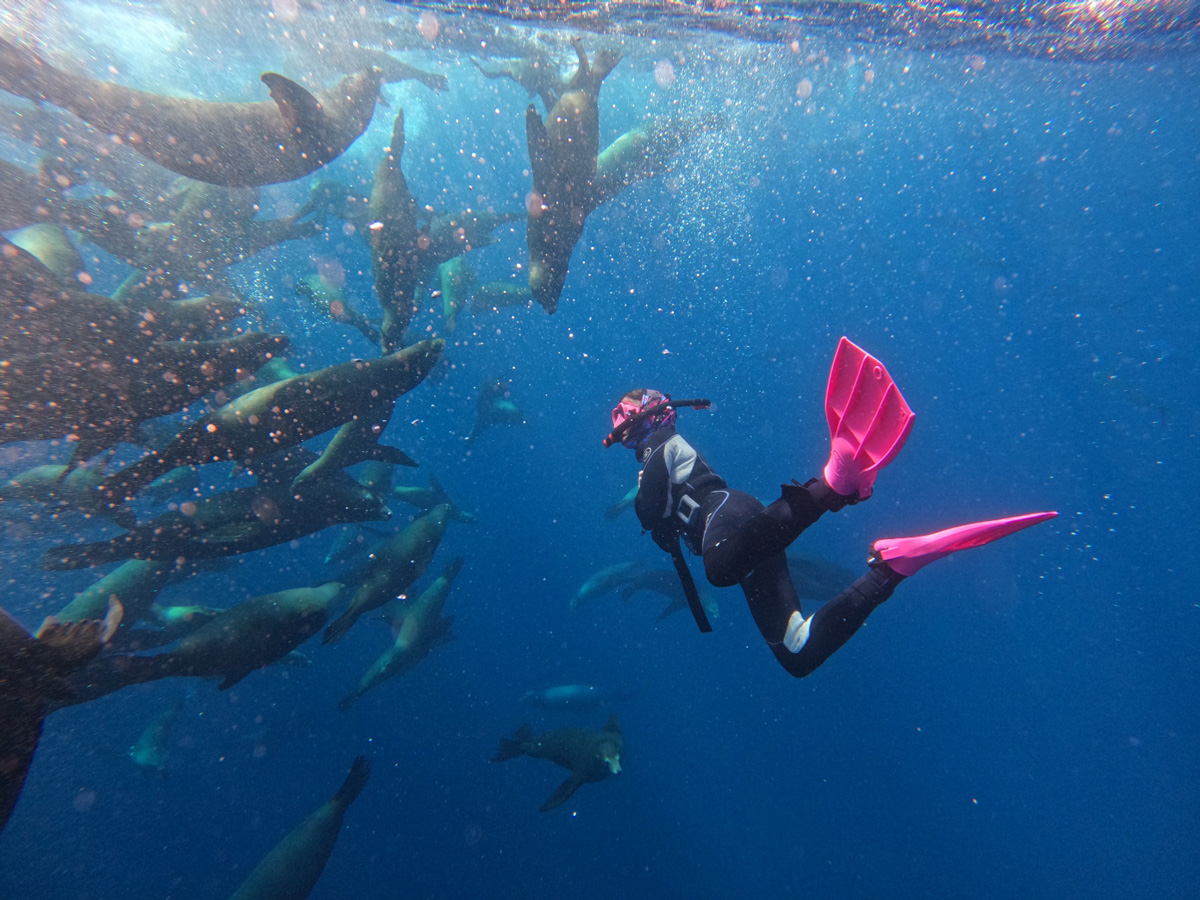Magdalena Bay is a remote destination off the coast of Baja California that transforms into a hub of marine activity during the annual sardine run. This natural phenomenon, often overshadowed by South Africa’s more famous sardine run, offers a bucket-list experience for snorkelers and freedivers who want to witness one of nature’s most incredible spectacles.
At Magdalena Bay, you can swim alongside vast schools of sardines and witness the feeding frenzy of predators such as marlins, sharks, sea lions, and dolphins. It’s an adrenaline-pumping adventure that few people know about and creates memories that last a lifetime. If you’re looking for an adventure off the beaten path with an impressive array of wildlife, Mexico’s sardine run could be for you.

Photo courtesy N. Curzon
Experiencing Mexico’s Sardine Run
Unlike most bucket-list dive experiences, the sardine run at Magdalena Bay is done exclusively through snorkeling and freediving, which allows you to move quickly in the water and spend all day watching the bait ball action. The constantly shifting schools of fish and their predators make this a highly exciting and unpredictable experience.
Swimming alongside millions of shimmering sardines as they swirl in unison is an awe-inspiring sight. As marine predators close in, the sardines create dense bait balls that move rapidly in an attempt to evade capture, and witnessing this action (and trying to keep track of it) is nothing short of captivating.
This isn’t a dive experience for the faint-hearted; the dynamic nature of the event requires stamina, and your time in the water is filled with surprises as different predators arrive in search of a meal.
For freedivers, the ability to dive down and observe the action from different angles brings a whole new perspective. The sardines sometimes sit lower in the water and marlin will often stay deeper while dorado hunt at the surface. It’s not uncommon for freedivers to witness the rapid movements of marlins as they spear through the bait balls. This combination of snorkeling at the surface and freediving deeper into the action creates a unique perspective.
What marine life can you see?
The sardine run is not only an impressive display of the sardines’ agility and sheer numbers but also a feeding event for a variety of predators. When the sardines gather in vast numbers, they attract an array of marine life:
- Dolphins: Common and bottlenose dolphins are key predators during the sardine run, herding schools of sardines into tight bait balls and feasting on them. These highly intelligent creatures often work in teams, creating displays of synchronized hunting behavior.
- Sea Lions: The sea lions of Magdalena Bay also join the hunt, darting through the water with astonishing speed to catch sardines. They’re often seen in large groups, chasing bait balls up and down through the water column and feasting on the go.
- Sharks: While not as prominent as in South Africa’s sardine run, Magdalena Bay attracts species such as silky. They tend to swim at the edges of the bait balls and below the schools of sardines waiting for their chance to strike. When they strike, an impressive feeding frenzy reduces the bait ball size in a matter of seconds.
- Marlins: One of the standout features of the sardine run at Magdalena Bay is the presence of striped marlins. These sleek predators are some of the fastest fish in the ocean and use their sharp bills to slash through the bait balls, stunning their prey. Watching marlins in action is a rare and exhilarating sight.
- Whales: Humpback whales and fin whales occasionally make appearances during the sardine run, though they aren’t often directly involved in the feeding action. If you are lucky enough to see these ocean giants feeding on a bait ball, it will take your breath away. When you’re on the dive boat, keep your eyes on the horizon, as these massive creatures cruise through the area, often breaching and blowing on the surface.

A Typical Day at Sea During the Sardine Run.
A day at sea during the sardine run is busy, dynamic, and filled with stunning wildlife. Here’s what a typical day might look like:
- Early Morning Departure: The day typically starts early as you board a panga (small motorboat) with your guide and head out of Magdalena Bay and into the open ocean, scanning the horizon for activity.
- Searching for Action: Spotters and guides keep an eye out for feeding birds, which are a reliable indicator that sardines are nearby. Boobies, pelicans, and gulls dive into the water, signaling that a bait ball is active below the surface.
- Entering the Water: Once a bait ball is located, it’s time to enter the water and quickly position yourself near the action, keeping a safe distance but close enough to witness the unfolding drama. It can take practice to find the bait ball once you jump in the water, but you get used to it after a few attempts.
- On and Off the Boat: Throughout the day, you’ll alternate between being in the water and returning to the boat to reposition. The sardine run is highly dynamic, with bait balls forming and dispersing rapidly as predators chase their prey. Being fit and quick to respond to directions are key to staying in the action.
- Lunch Break: After an intense morning, there’s usually a break for lunch on the boat, often while cruising to another bait ball.
- Afternoon Diving: The action often continues into the afternoon, with more chances to jump in and witness the predator-prey dance. As the sun begins to set, you’ll make your way back to Magdalena Bay.
When is the Best Time to Experience the Sardine Run?
The sardine run at Magdalena Bay occurs in October through December, with the peak action typically happening in November.
Top Tips for Making the Most of the Sardine Run.
- Stay Flexible: The sardine run is unpredictable, with bait balls forming and dispersing quickly. Be prepared to enter and exit the water multiple times throughout the day, and embrace the spontaneity of the event.
- Get Fit: The sardine run is physically demanding, so make sure you are fit, bring snacks, and stay hydrated throughout the day. The excitement and constant activity can be exhausting, so pacing yourself is important.
- Bring the Right Gear: A quality wetsuit, snorkel, mask, and fins are essential for comfort and maneuverability in the water. You usually kit up early in your wetsuit and stay in it all day – so bring a windproof jacket to keep warm, plus a sunhat and polarised sunglasses with you. It’s also a good idea to bring motion sickness medication as the open-ocean swell can be challenging.
- Book with Experienced Guides: Local guides with knowledge of the area and experience tracking bait balls are crucial for making the most of your sardine run experience. They can help position you in the right spots and ensure you stay safe in the water. You can experience the sardine run on dayboats or via dedicated liveaboard trips.
- Photography and Videography: If you plan on capturing the action, bring a GoPro or underwater camera with a wide-angle lens. The fast-paced nature of the sardine run means you’ll want to be ready to shoot at any moment.
What else can you do in the area?
There is a lot of great diving in Baja California, so take time to explore before or after your Magdalena Bay trip if you can. It is easy to get around the peninsula by shared or private car transfers.
The Cabo Pulmo National Park is a conservation success story that offers diving off the beaten path, with vast schools of jacks and tropical fish. Nearby La Paz and the Sea of Cortez boast whale sharks, hammerhead sharks, manta rays, schooling mobula rays, orcas, and sea lions. Cabo San Lucas is a bustling destination that offers some great local diving, but most importantly, it’s the departure point for liveaboards to the world-famous Socorro Islands.
This article was written by Kathryn Curzon, a shark conservationist and dive travel writer for SSI (Scuba Schools International).
